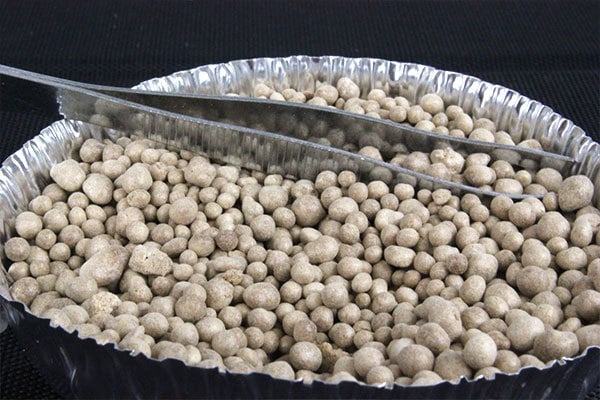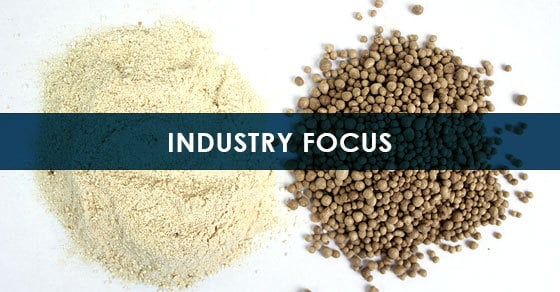Pulverized gypsum products were the standard for agricultural gypsum for many years, but as growers look to maximize their return on investment, they are increasingly turning toward pelletized gypsum – a premium alternative.
Pelletized gypsum offers several significant advantages over other forms of gypsum such as pulverized or ultra-fine gypsum, many of which can be tied right back to the bottom line. This has led to increased grower adoption and a greater demand for fertilizer and soil amendment producers to offer gypsum in a pelletized form. Producers are also finding that they stand to gain a few benefits from offering a pelletized product as well. Here’s why.
About Pelletized Gypsum
Pulverized gypsum is a powdered form of gypsum that may be derived from a variety of sources, both natural and synthetic. It may be mined and crushed into a powder, or it may be in the form of dust or fines resulting as a byproduct from another mining or processing operation. As such, powdered and pulverized gypsum products are available in a variety of grades.

Pulverized gypsum being used for testing in the FEECO Innovation Center
Pelletized gypsum can be derived from the same sources, but is upgraded in particle size by the pelletizing or wet granulation process – a form of agitation agglomeration. The granules produced in this process are round and generally fall between 2-5 mm in size (4 x 10 mesh).
Depending on the specific product parameters desired (bulk density, particle size distribution, etc.), various types of equipment are available for pelletizing gypsum, including pin mixers, rotary agglomerators, pugmill mixers, disc pelletizers, and a combination thereof. The most common approach employed for soil amendments and fertilizers is the pin mixer-disc pelletizer combination, as this produces a highly refined granular product and allows for improved size control.

Pelletized gypsum produced during process development testing in the FEECO Innovation Center
Benefits of Pelletized Gypsum
Growers have long recognized the benefits of applying gypsum – a source of essential sulfur and calcium, a natural aerator, and much more – to their soils. Apart from the fact that it is what has traditionally been used, the allure of pulverized gypsum is that it is available at a lower cost. It is also considered “fast-acting,” meaning that the product goes to work almost immediately, courtesy of its fine particle size and subsequent high surface area to volume (SA:V) ratio.
But a variety of factors can stand in the way of realizing gypsum’s full benefits when it is applied as fines. By pelletizing gypsum, producers can help their growers to fully realize gypsum’s benefits, while also maximizing their return on investment. And while pelletized gypsum incurs a higher cost, due to the additional processing that goes into producing the product, it has a few advantages that make it worth the extra investment – for both the grower and the producer.
Benefits to Growers
Growers are able to take full advantage of their gypsum application when using a pelletized product. This is because pelletized gypsum is not dusty, offering several benefits that contribute to its performance and effectiveness:
Reduced Product Loss
A dusty product is difficult to handle and apply; material is frequently lost in the process. Further, applying powdered gypsum to fields often results in a portion of the product becoming windblown, causing the farmer to lose some of the investment before it even hits the ground.
More Predictable Results
A dusty product also makes results less predictable, causing product to be unintentionally deposited in surrounding areas, and leaving the farmer to guess how much of the application actually stayed on the field.
Improved Flowability = Easier Handling & Application
Pelletized gypsum is almost entirely dust-free, allowing growers to apply gypsum with ease and achieve accurate application results. Pelletized gypsum is also significantly more flowable than powdered gypsum, preventing clogging and caking issues.
Additionally, pelletized gypsum does not require special spreading equipment.
Uncompromised Delivery Rate
While it’s true that the smaller the particle size, the faster the active ingredient delivery, this should not deter growers from selecting a pelletized product over a powdered one.
Pellets produced via agitation agglomeration are manufactured to hold up to the rigors of handling and transportation, while still breaking down for fast delivery upon application (in the presence of sufficient moisture).
All of these benefits give growers a greater opportunity to increase their yields and maximize their investment.
Benefits to Producers
In addition to satisfied customers, producers can also gain some advantages by offering a pelletized product.
More Diverse Product
The pelletizing process is inherently flexible, allowing producers to incorporate beneficial additives into their process to enhance performance and nutritional value. This plays well into the rising trend of specialty fertilizer and soil amendment products; the pelletizing process opens the door to a more specialized approach to fertilizer and soil amendment production.
Enhanced Control Over Product Specifications
When utilizing a disc pelletizer, the most common approach to pelletizing, the flexible nature of the process also gives producers enhanced control over particle characteristics, allowing them to meet exacting market specifications as needed. By adjusting different variables on the disc pelletizer, producers can target various parameters in the end product, such as:
- Particle size distribution (PSD)
- Rate of dissolution
- Crush strength
- Delivery rate
- And more
Increased Blending Potential
Unlike powdered or pulverized products, pelletized gypsum can be easily blended with other granular fertilizer and soil amendment products. This gives producers the opportunity to increase their offerings by creating different blends, or by selling their gypsum to fertilizer blending plants.
Testing & Developing a Gypsum Pelletizing Process
Producers interested in exploring pelletizing as a method of processing their material can utilize testing facilities such as the FEECO Innovation Center to trial their unique source of gypsum for pelletizing.
Gypsum process development testing not only shows proof of concept and proof of process, but it also allows producers to gather the data necessary for process scale-up and commercial-scale equipment design.
The variation across different sources of gypsum requires a thorough test program to work through processing challenges and refine production parameters.
Conclusion
While pulverized and powdered gypsum products have long been the agriculture industry standard for field application, the benefits that a pelletized product can provide are seeing products trend toward this alternative. The product not only offers benefits to growers, but to fertilizer and soil amendment producers as well.
Testing is a critical aspect of developing a successful pelletized gypsum product, due in large part to the variation exhibited across sources.
Serving the industry since 1951, FEECO is the world’s leading authority on agitation agglomeration and the production of fertilizers and soil amendments. We offer support for every step of the process, from feasibility testing and process development, to custom equipment manufacturing, and parts and service support. For more information on our gypsum production equipment and services, contact us today!



